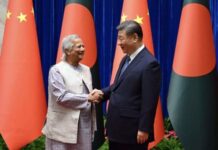
Taliban Tries to Build Diplomatic Bridges
Relations with Neighbouring Countries
One of the reasons for the expected turmoil in Afghanistan is that several countries in the vicinity are interpreting the post-U.S. power vacuum in Afghanistan as an opportunity.
Iran and Saudi Arabia want to dominate Afghanistan to ensure they stay ahead in the race for regional hegemony. Both are working in coordination to maintain unity among the Taliban who have representatives from various ethnic groups and clans that are expected to jostle for political power.
Afghanistan is in the heart of South Asia, Central Asia and West Asia and there cannot be a political vacuum in this unique region.
In August 1998, Taliban forces attacked the Iranian consulate in Mazar-i-Sharif and killed 10 Iranian diplomats and a correspondent of IRNA, Iranian News Agency. Iran, at the time, supported the anti-Taliban Northern Alliance that operated mainly out of the Panjshir Valley under the leadership of Ahmad Shah Massoud. However, this time around Iran is not in an axis with India, Russia and Tajikistan in dealing with the Taliban which made the Tehran-Taliban harmony possible.
This time Iran has taken a bold initiative to overcame past bitterness with the Taliban. Iran’s growing confidence in handling the Taliban had been on display since Al Quds force under Qasem Soleimani took interest in building ties with the Taliban. Iran’s Quds Force now under the leadership of Esmail Qaani, who succeeded General Soleimani after his assassination on January 3, 2020 has been building stronger links with the Taliban which has been a cause of concern for Saudi Arabia.
Apart from hosting the Taliban leaders repeatedly in the past, Iran has already shown its goodwill to the Taliban by resuming export of energy to Afghanistan, which is yet to form a formal government. Iranian moves and the Saudi-Pakistan initiatives point to the rivalry between the two regional blocks. The Iranian and Saudi moves on Afghanistan indeed are the real indicators of the shape of the future of Afghanistan.
Ethnic Divisions and Taliban Unity
Despite its current reign over popular imagination, that of a unified whole, united under an Islamic goal, Taliban is not a unitary organisation. It is a collation of a large number of local militia, banded together on ethnic/tribal lines.
It is a moot question as to how the spoils will be distributed between the Pashtun tribes, while the other groups from Jalalabad and Nuristan have also raised their demands. The key differences appear to be on policy with regard to women, education, narcotics, existing source of riches and China, despite its violation of the rights of Uyghur Muslims, anathema to an Islamic Emirate.
What allowed the Taliban to take over — a series of local deals along tribal lines — may well stop them from forming the political coalition necessary to form a government.”
The Helmandis were reported to have taken over the Ministry of Finance on August 17, reflecting their desire to control that ministry, possibly in order to facilitate their control of opium and heroin production in Helmand — the largest producer of opium in Afghanistan. Surprisingly, a week later, Helmandis were appointed, not just as Finance, but also as Ministers of Interior and Defence. This tilts the balance between the rustic, rural, opium-rich Helmandis and the militarily superior Haqqanis.
There are also contradictory reports of Helmandis/Kandaharis and Haqqanis taking over control of the security of Kabul, both sets of factions not very keen to cooperate on sharing the spoils of war. This regionalisation, added to ethnic factionalism, makes this coalition very difficult to build.
Multiple other schisms are emerging, including the absence of representation of the northerners, the Tajiks, Uzbeks and Hazaras — main beneficiaries of the past two decades and with a large presence in Kabul’s 5-6 million population. The more the Taliban beat common people on the streets with chains and with every single wanton killing, they are to be seen as an occupational force by these segments, making their victory tenuous.
There are other groups too – al-Qaeda, IS-Khorasan, Uighurs (ETIM), Uzbeks (IMU), Tajiks (Khatiba Imam al Bukhari) and Pakistani groups such as the TTP, LeT, JeM, Jamaat ul Ahraar, Lashkar-e-Islam and Lashkar-e-Jhangvi. All of them have linkages with Taliban fighters on the ground but power-sharing negotiations may end up pitching them on opposite sides.
Al Qaeda
The Taliban government was ousted by a U.S.-led intervention following the Sept. 11, 2001, attacks on the United States masterminded by al Qaeda leaders based in Afghanistan, and 20 years of warfare followed.
The Taliban had provided al-Qaeda with sanctuary while it ruled Afghanistan from 1996 to 2001. The US invaded and overthrew the Taliban after it refused to turn over al-Qaida leaders following the Sept. 11, 2001 attack. During the course of the 20-year US war, al-Qaeda was vastly diminished, but questions have arisen about its future prospects.
In a February 2020 agreement with the Trump regime, Taliban leaders pledged not to support al-Qaeda or other extremist groups that would threaten the US. But US officials believe the Taliban maintain ties to al-Qaeda, and many nations, including Gulf Arab states, are concerned that the Taliban’s return to power could open the door to a resurgence of al-Qaeda influence.

















